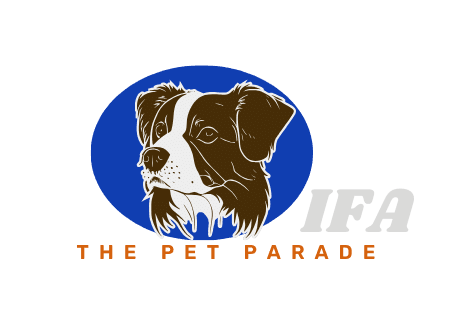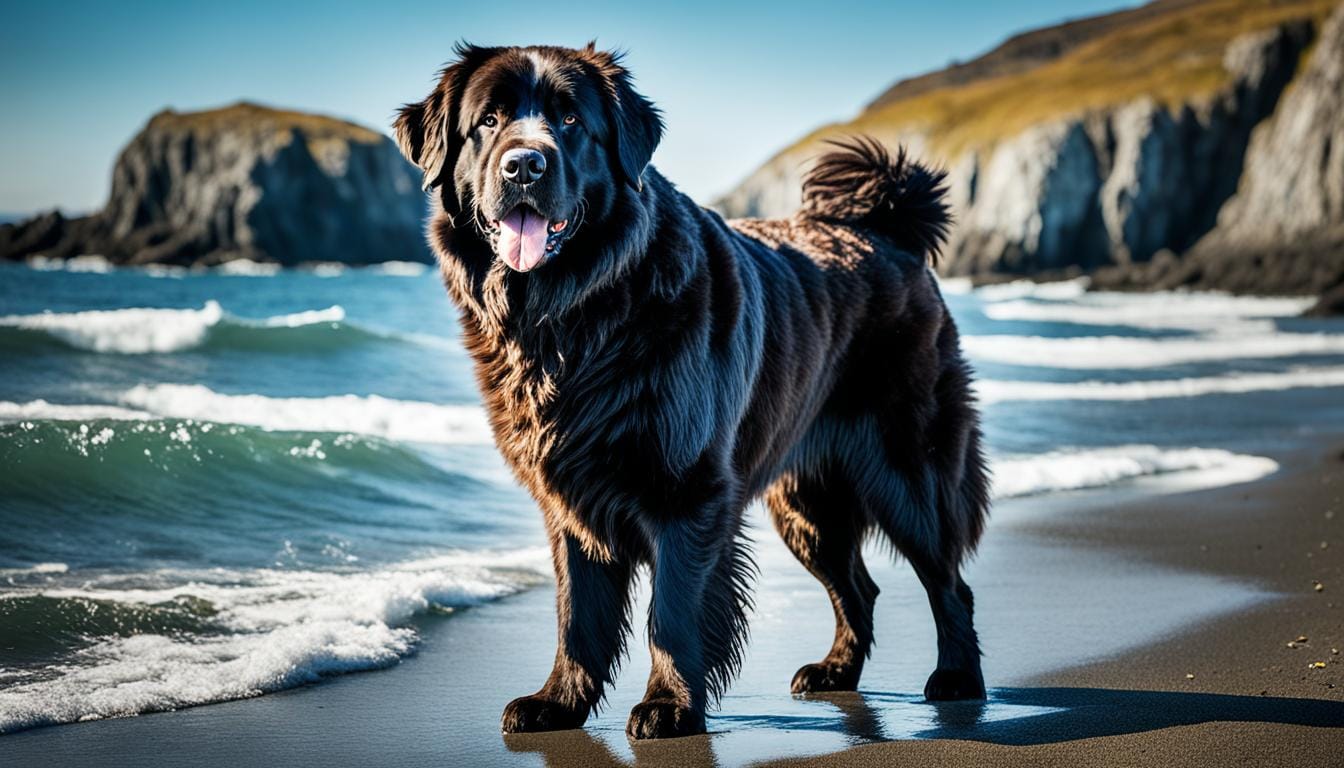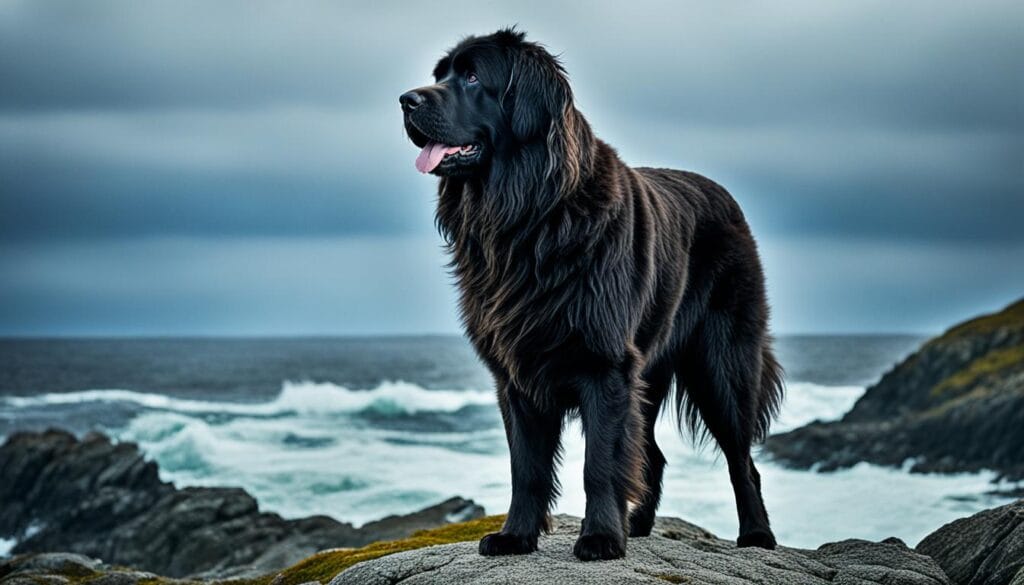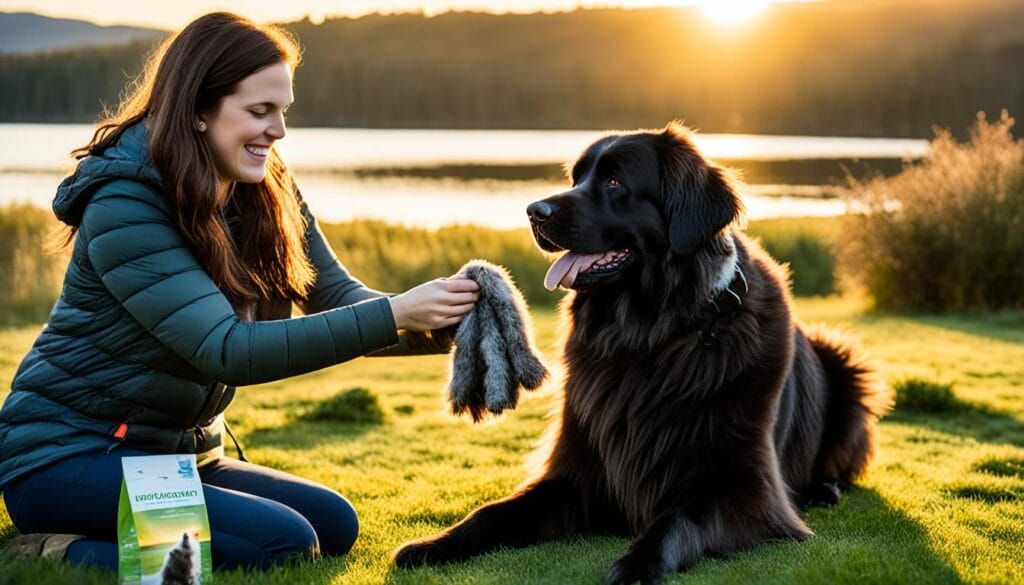Known for their big size and friendly ways, Newfoundland dogs are often called Newfies. They come from Canada and stand out with their notable features. This includes a thick double coat that’s medium-length and comes in colors like black, brown, gray, and white with black. They have webbed feet – a great help for swimming. Males can reach 28 inches tall and weigh 130 to 150 pounds. Females are a bit smaller, standing 26 inches tall and weighing 100 to 120 pounds.
These dogs are very loving and get along well with kids and other animals. They also don’t need a lot of exercise but enjoy playing. Teaching them requires being patient and keeping up with exercises like basic commands and getting them used to being around new people and animals. Keeping a Newfie clean means brushing them weekly and giving them baths regularly. It’s also important to watch out for health issues like hip problems, heart conditions, and cystinuria. Typically, they live 9 to 10 years.
Key Takeaways
- Newfoundland dogs are a giant breed originating from Canada.
- Males weigh between 130 to 150 pounds; females 100 to 120 pounds.
- They have a medium-length double coat in various colors.
- Known for their high intelligence and moderate trainability.
- Health concerns include hip dysplasia and heart disease.
Introduction to the Newfoundland Dog
The Newfoundland Dog is known for more than being a pet. It’s a loyal companion with a calm and dependable nature. Its story began in the 1700s on the island of Newfoundland, Canada. There, they were prized for their strength and help with fishing tasks.
The dogs are quite large. Males stand about 28 inches tall and weigh 143 to 176 pounds. Females are a bit smaller, at 26 inches and 121 to 143 pounds. Their size reflects their role as working dogs, similar to mastiffs and Molosser types.
The Newfoundland breed history takes a key turn in the early 1800s when they made their way to England. There, their friendly nature won over many hearts. This led to them being loved as both family pets and show dogs. In 1886, the American Kennel Club officially recognized their breed.
One unique feature of the Newfoundland Dog is its thick, double coat. They need regular grooming to keep their fur from tangling. These dogs also have webbed paws that help them swim well. Males usually weigh between 130 and 150 pounds. Females are a bit lighter, between 100 and 120 pounds. They are truly gentle giants, making them great for families.
The Newfoundland Dog stands out for being a loyal companion. They are devoted and make strong connections with people. Their history of hard work around the water shows why they are so well-loved. Both pet owners and breeders value them a lot.
Unique Traits of the Newfoundland Dog
Newfoundland dogs are known as the gentle giant. They stand out for their huge size and friendly nature. These traits make them perfect as a family pet. They also do well in different jobs because they are smart and easy to train.
Physical Appearance
Their Physical Appearance is quite striking. They are big and strong, quite muscular. They stand about 25-28 inches tall and weigh 100-150 pounds. They have a thick double coat that can be black, brown, gray, or Landseer. Their feet are webbed, and they have big lungs, which helps them swim well. This makes them great at water rescues.
Temperament
Newfoundlands are loved for being incredibly sweet-tempered. They are gentle and level-headed. This makes them an excellent pet in homes with kids. They are very patient and love to show they care. They get along with other pets and even with people they don’t know. This shows how well they do in different social situations.
Intelligence and Trainability
The Newfoundland Dog is quite intelligent. They learn quickly and follow orders. They really like making their owners happy. Teaching them with positive methods is best. They can learn everything from simple to advanced commands easily. This includes tasks like water rescues, showing their quick wit and usefulness in many roles.
The Newfoundland Dog as a Loyal Companion
The bond between a Newfoundland dog and its family is special. This breed is a loyal companion. It enriches every home it joins. These gentle giants started out in the 1700s on Newfoundland in Canada. They are known for their loyalty and protectiveness, making them treasured family pets.
Males of this breed weigh 130-150 pounds, and females 100-120 pounds. They stand 26-30 inches at the shoulder. This size shows they’re reliable protectors. They have a friendly and calm nature, forming close bonds with their families. Their loyalty to loved ones is clear.
Newfoundlands are protective. They look after and help their family members every day. They can tell when someone needs caring for. This makes them amazing companions in any family situation.
Their loyalty comes with a strong desire to work. They were first used for water rescues and by fishermen. Today, they are still excellent at jobs needing trust. They are more than pets. They’re truly valuable parts of families.
To keep them healthy, regular grooming is a must. You should brush them a few times a week. When they shed, you’ll need to groom them even more. Be aware of health issues they might face. Look for breeders who test for health to get a healthy puppy.
By understanding and encouraging the Newfoundland’s natural traits, they become essential family pets. Their loyalty and gentle nature are what make them beloved around the world.
Caring for a Newfoundland Dog
Caring for a Newfoundland Dog means more than basics. It’s about their full well-being, including physical and mental needs. For caring for Newfoundland Dogs well, you must know what they need. This ensures they live a happy, healthy life.
Feeding and Nutrition: They need a diet that fits their big size and keeps them healthy. Because of this, they eat more than other dogs. Quality food helps their big bodies stay healthy. Feeding them every 12 hours can prevent stomach issues like GDV.
Exercise and Mental Stimulation: These dogs need moderate exercise to stay happy and healthy. Daily walks and time to swim are great for them. Don’t forget about their smart minds. They also need mental challenges like with toys or training.
Grooming: Their thick fur needs a lot of care to avoid tangles and control shedding. Brushing them weekly and more often when they shed helps. Bathing and grooming by a professional also play a part in their coat’s health.
Health Monitoring: Keeping an eye on their health is very important. Check them often for any signs of health problems. This includes visiting the vet regularly to make sure they’re in good health.
Housing and Environment: Due to their large size, they need a lot of space. They do best in homes where they have plenty of room to move and play.
To sum up, giving proper, consistent care ensures Newfoundland Dogs are happy and healthy. This means right food, enough exercise, good grooming, and watching their health closely.
Training Tips for Newfoundland Puppies
Training Newfoundland Puppies takes time and specific skills because they are smart. Teaching them Basic Obedience early is key. Start with commands like “sit,” “stay,” and “come.” Use positive rewards and do short lessons each day to build good habits.
Basic Obedience Training
Start training your Newfoundland pup as soon as possible. They learn fast and love to make you happy. Switch up their lessons to keep it interesting. Short, fun training sessions, lasting 5-10 minutes, are best. Always reward them positively; they do better with love than toughness.
Keep things the same in Newfoundland Dog training. Consistent commands and treats they love make learning easier. Train in different places to help them concentrate and listen despite distractions.
Socialization Strategies
Socializing is crucial for Newfoundland pups to become friendly adults. At 8-12 months, the first fear period starts. It’s a big time to show them various environments and meet different people and animals. This makes them more confident and friendly.
Start early safe socialization at 10-12 weeks. This is a critical phase. It helps your Newfoundland Dog become a polite friend.
Special Considerations for Giant Puppies
Because Newfoundlands grow quickly, they need special care in their puppy stage. They are fully grown by 18 months, which is later than many dogs. Be sure to give them a safe and comfy space. Use flooring that’s not slippery and easy exercises to protect their joints.
Regular training and gentle touch from the beginning will help in their development. Choose a breeder who knows about early socialization to make Newfoundland Dog training easier.
| Training Aspect | Tips and Recommendations |
|---|---|
| Basic Obedience | Start early with commands like “sit,” “stay,” and “come.” Use positive reinforcement. |
| Socialization Strategies | Introduce your puppy to various environments and people. Safe exposure during the fear period is crucial. |
| Special Considerations | Provide a comfortable environment with non-slip floors and avoid harsh treatment to prevent shutdowns. |
Exercise Needs of the Newfoundland Dog
Newfoundland dogs have moderate exercise needs. It’s vital for their health and mind. As skilled water rescue dogs, they adore swimming and walking. These activities are perfect for keeping them fit. Also, taking part in sports and fun activities uses their job skills and talent.
When planning exercises for Newfoundlands, consider their age, weight, and health. Give them the perfect amount they need. A well-fit exercise plan is key for their well-being.
- Puppies: Two 15- to 20-minute intervals of exercise per day
- Adolescents: 30-minute intervals of exercise twice a day
- Adults: 30 to 60 minutes of exercise per day
- Seniors: Around 20 to 30 minutes of gentle exercise per day
| Group | Daily Exercise Time |
|---|---|
| Puppies | 30-40 minutes (split into twice a day) |
| Adolescents | 60 minutes (30-minute intervals twice a day) |
| Adults | 30-60 minutes |
| Seniors | 20-30 minutes |
Mental exercise is as important as physical activity. It keeps Newfoundland dogs from getting bored. Daily play or several times a week is needed. An adult Newfie usually needs about an hour of exercise daily. This makes sure they’re happy and healthy.
Recognizing Health Concerns in Newfoundland Dogs
It’s important to know and deal with health issues in Newfoundland Dogs. This is key to their well-being and long life. These dogs often face problems like joint issues, heart conditions, and genetic diseases. Identifying these early helps prevent big complications and treats symptoms quickly.
Common Health Issues
Newfoundland Dogs might deal with various health problems. Hip or Elbow Dysplasia, for instance, can cause mild to severe issues, even needing surgery. Osteochondrosis mainly affects young, rapidly growing dogs. It often needs surgery but usually has good results.
Another issue is Panosteitis, which is self-limiting between 6 to 18 months. If severe, temporary medicine and less activity can help.
- Hip or Elbow Dysplasia: Can range from mild arthritis to surgery needs.
- Osteochondrosis: Mainly affects young dogs, can require surgery.
- Panosteitis (Pano): Affects young dogs, may need medication and rest in severe cases.
- Subaortic Stenosis (SAS): Inherited, has a sudden death risk, especially severe cases.
- Dilated Cardiomyopathy (DCM): Occurs later in life, research ongoing on diet risks.
- Cystinuria: Leads to frequent bladder infections, identifiable through DNA tests.
- Allergies: Need proactive handling to prevent skin, ear, or gut troubles.
- Hypothyroidism: Causes tiredness, skin issues, and weight gain; may not show symptoms in some.
For more on these health issues and tips, visit this link.
Preventive Care Tips
Preventing issues is vital for Newfoundland Dogs. This includes regular vet visits and certain home practices. These can make a big difference in the dog’s health.
- Balanced Diet: A diet that fits the dog’s size and health is critical.
- Regular Grooming: Weekly brushings help find problems and maintain their coat.
- Exercise Moderation: Don’t overdo it, especially as they grow.
- Vaccinations and Health Screenings: Keeping up with these prevent many diseases.
Following these steps can really improve the health and well-being of Newfoundland Dogs. It helps them enjoy a long, happy life.
Grooming Requirements for Newfoundland Dogs
Keeping Newfoundland dogs looking good means a lot of grooming. Their thick, double coat needs regular attention. It’s best to brush them every week, or even every day. This is especially true in the fall and spring when they shed a lot.
Grooming these big dogs means you need the right tools. You’ll use a pin brush, comb, dog rake, slicker brush, dog dryer, grooming table, and nail clippers. Each one is important for different parts of their care. A grooming table makes things a lot easier for you and the dog.
They should get a bath every 6-8 weeks. But, how often depends on how much they play and get dirty. Dog dryers made for their thick fur are a big help. A good grooming schedule is key to keeping their coat clean and healthy.
For Newfoundland dogs, grooming should be a happy time. It helps avoid stress and makes them more likely to help. Make sure to keep their teeth clean and their nails trimmed too. It’s all part of keeping them looking great.
- Weekly or daily brushing during shedding seasons
- Use of specific grooming tools
- Bi-monthly bathing routines
- Establishing a grooming schedule
- Emphasizing a positive grooming experience
| Tool | Purpose | Cost Range |
|---|---|---|
| Pin Brush | Remove loose hair and debris | $10 – $30 |
| Comb | Detangle and smoothen fur | $5 – $20 |
| Dog Rake | Break up mats and tangles | $15 – $40 |
| Slicker Brush | Remove mats and dead hair | $10 – $50 |
| Dog Dryer | Dry thick coat efficiently | $100 – $600+ |
| Grooming Table | Establish a grooming area | $50 – $250 |
| Nail Clippers | Trim nails regularly | $10 – $30 |
The History and Origin of the Newfoundland Dog
In the early 19th century, the Newfoundland Dog began its journey. It was a trusted working partner for Canadian fishermen. Their family tree includes ancestors like Great Pyrenees dogs and black retrievers. Thanks to French fishermen between 1506 and 1662, the breed found its start in Newfoundland. They brought Pyrenees sheepdogs and black retrievers there. These mixes set the stage for the dogs we love today.
Sir Edwin Landseer highlighted the breed in England around 1837. He painted the famous black and white Landseer Newfoundland Dogs. This art made the breed more well-known. At that time, the dogs showed traits similar to mastiffs. Breeding improved the Newfoundland’s features over time. This led to new types like the Landseer Newfoundland and smooth-coated retrievers.
Around 40 years later, the breed entered North America. It came through importing of dogs from Newfoundland that were white, black and white, and nearly black. The North American Newfoundland Club then started to keep the breed strong. They did things like giving gold prizes and cash rewards at events. The 1924 Westminster show was a key place for these efforts.
During World War I, a sad moment hit the breed in England. It was when some dogs were poisoned, threatening their future. But in North America, people worked hard to save the Newfoundland Dog. Their efforts paid off and the breed survived.
The 1960s brought a big moment for the Newfoundland Dog. Since then, it has been on the rise in popularity. For the past 20 years, more and more people want these smart, kind, and loyal dogs. The Newfoundland Dog’s story shows its lasting strength and charm. This ensures it remains loved everywhere.
Why Newfoundland Dogs Make Great Family Pets
Newfoundland Dogs are more than pets; they’re “Gentle giants.” They’re known for their friendly ways, making them great family dogs. They even earned the nickname “the nanny dog” because they’re so gentle, perfect for homes with kids. But, remember, not all of them show this behavior at first, especially as quick-growing puppies.
One key trait that stands out in Newfoundland Dogs is how happy they are with their families. They need lots of love and can act out if left alone too much. To keep them happy, families should spend plenty of time with their Newfie members.
The Gentle giant nature of Newfoundland Dogs might not be clear right away. It takes a few years. Good training is vital during this time. It helps them learn manners and stop bad habits like nipping or barking.
Getting a Newfie also means being ready for various costs. These include training, food, vet care, and specific health issues. Being prepared for these expenses is key for their health and happiness.
They’re also known for being messy, shedding a lot and slobbering. Families adjusting to less-than-perfect cleanliness is essential. But, with patience and teaching, you can still have a cozy home with your Newfie.
For homes with kids, teaching them to be gentle and respect the dog is crucial. This keeps everyone safe and happy. It creates a place of calm and joy for the whole family.
Newfoundland Dogs truly bond deeply with their families. They give loyalty, comfort, and happiness like no other. This bond is why they are so highly valued as family pets. They offer a love and friendship that is truly special.
Famous Newfoundlands in History
Over time, several notable giant breeds have won over many. Of them all, the Famous Newfoundland Dogs are special. They are loved for their friendly ways and brave actions.
Consider Seaman, who went with Lewis and Clark on their exploration from 1804 to 1806. Seaman showed the deep connection between man and dog. This happened during a key time in American history. Boatswain, Lord Byron’s pet, is another great example. He highlights the long-standing charm of these Famous Newfoundland Dogs.
Newfoundlands are not just great friends. They are also part of big moments in history. For example, Faithful lived in the White House with Ulysses S. Grant’s son, Jesse. This line of Famous Newfoundland Dogs continued with Nana, who inspired a character in a famous novel.
When it comes to courage, Gander shone as a WWII hero. He was known as “Sergeant Gander” and was very brave. He showed his valor during the Battle of Hong Kong. Rigel is also remembered for guarding the Titanic’s survivors.
In dog shows, Newfoundlands have made their mark. Josh won the Westminster Kennel Club’s Best in Show in 2004. This was big news for Famous Newfoundland Dogs.
These notable giant breeds have done great things. Like Hairy Man saving 163 shipwrecked people. Their heroism, faithfulness, and friendship make them beloved worldwide. Their legacy is a story of courage and love that wins everyone’s heart.
Conclusion
The Newfoundland Dog is big and loyal, making it a wonderful life partner. It’s more than just a powerful pet. It needs a special kind of care to thrive. This includes regular grooming, socializing them, and teaching them.
These dogs have unique traits. They have a thick, double coat that needs a lot of grooming. Think about their special health needs and be ready to care for them well.
To keep a Newfoundland happy, they need physical and mental exercise. Regular walks and playtime are key. Males are often bigger, standing about 30 inches and weighing 130-150 pounds. Females are a bit smaller. They stand about 28 inches and weigh 100-120 pounds.
Because they can face problems like hip issues and getting too heavy, regular vet visits are critical. Don’t forget about a healthy diet.
Newfoundland Dogs offer not just love but also help. They need a lot of attention, mainly when it comes to grooming and keeping active. They can truly bring joy to their families with the right care.
























